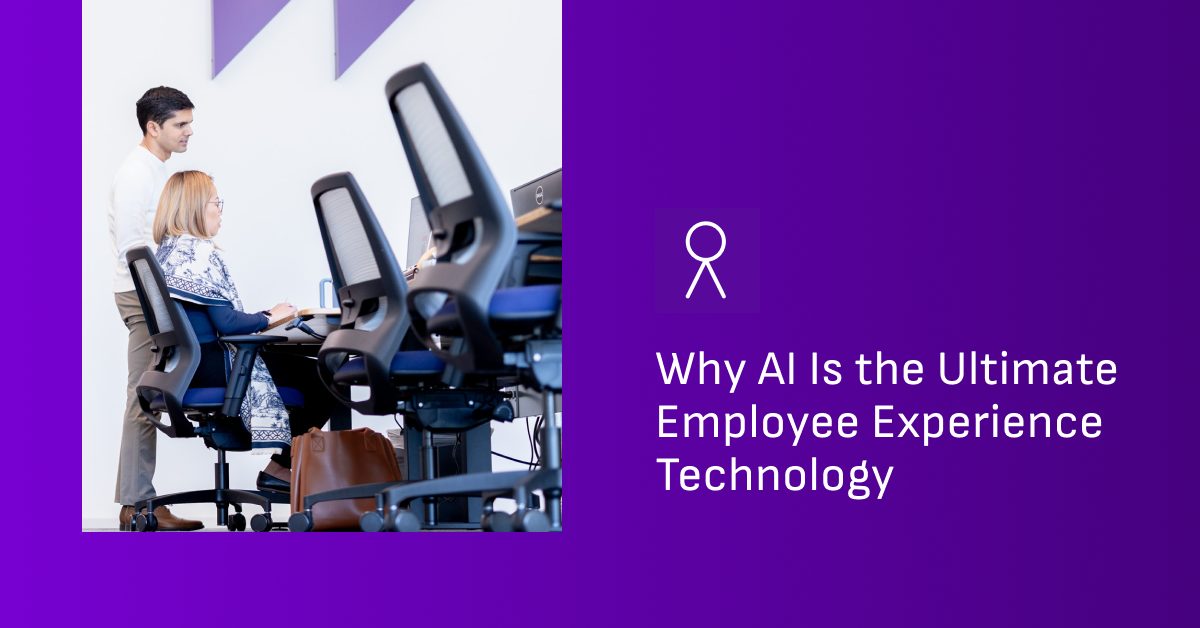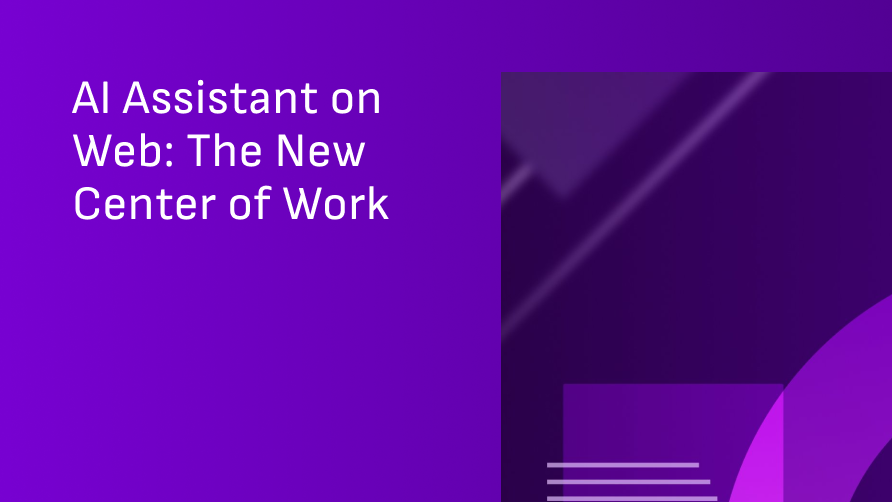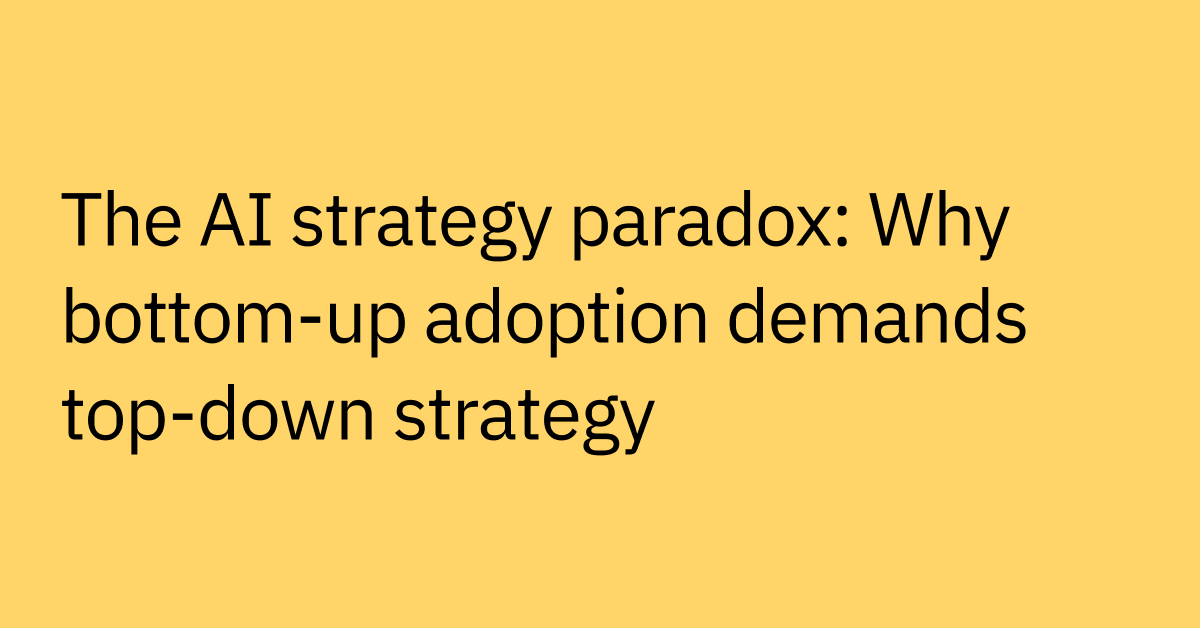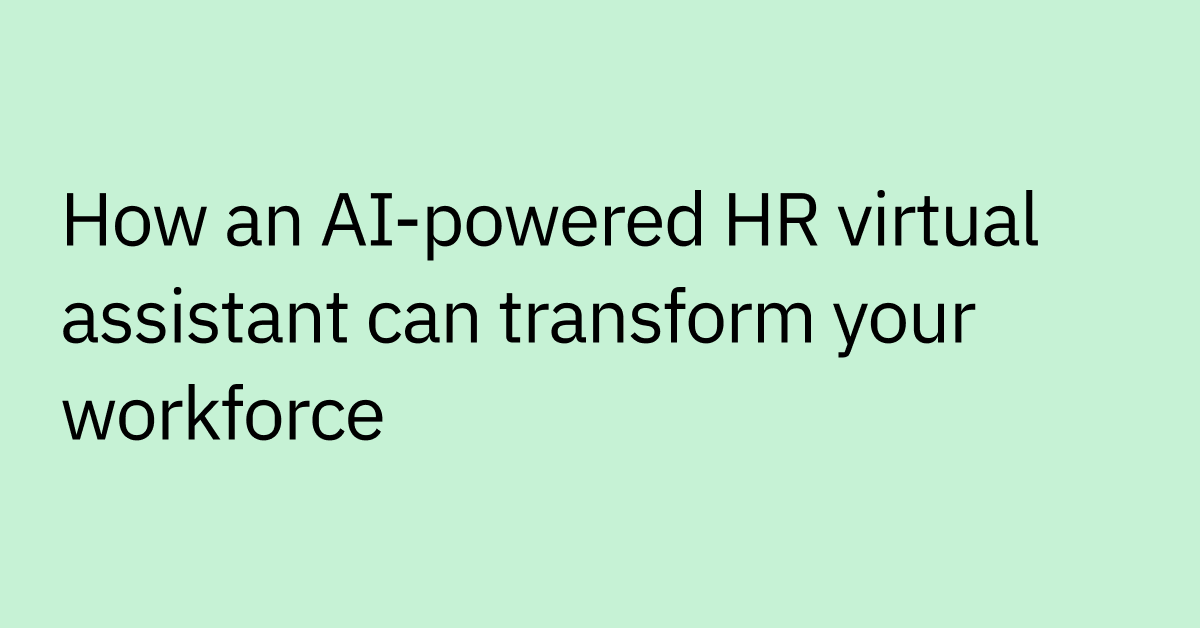Your technology doesn’t just help your exployees do their job: it also plays a vital role in shaping their experience and impacting employee satisfaction and efficiency.
The right employee experience (EX) support can help address challenges ranging from low employee engagement to cumbersome multi-application, multi-step workflows that drain productivity. So what kind of tech makes this possible and what considerations are needed for EX success?
In this article, we'll explore how:
- Enterprise tech impacts employee (and support team!) engagement and productivity
- Why employee experience tech shouldn’t be limited to HR
- Implementing AI solutions can positively impact on employee retention and productivity levels
But how exactly do you leverage AI solutions for better EX? Read on to find out.
What is employee experience technology?
Employee experience technology refers to tools and platforms that are able to support employees and increase their engagement, productivity, and satisfaction throughout the employee lifecycle.
This technology is able to facilitate seamless collaboration, streamline employee communications, provide access toresources, and simplify everyday tasks too.
Just like an orchestra is made up of diverse instruments that work together to harmonize, employee experience (EX) technology is able to synchronize various workplace tools and processes to create a more seamless, unified experience for employees.
Employee experience technology can encompass a wide range of tools, including:
- Intranet portals
- Learning management systems (LMS)
- Employee self-service portals
- Team collaboration software
- AI-powered assistants
Of this list, an enterprise AI assistant can be especially powerful, enabling your teams to access and take action across these systems.
With today’s large enterprises using an average of 664 apps, helping to unify your tools, avoid switching applications, and create a seamless work experience goes a long way to enabling productivity.
Why employee experience isn’t just an HR initiative
Who would you say is responsible for the employee experience? If the HR department is the first to pop into your mind, you’re not alone.
But here’s the thing: Employee experiences extend far beyond HR. The EX is impacted by a wide range of factors, many of which intersect with other departments, like legal, facilities, IT, finance, and operations.
For example, clunky software would fall under the purview of the IT department, broken equipment under the operations department, complex contracts under the legal department, and slow reimbursements under the finance department.
You risk ignoring such issues if you consider EX an HR initiative. This could result in negative business outcomes, like lower employee engagement and productivity.
Enterprises must consider the digital employee experience
Even with a great work environment and perks like free coffee or gym memberships, you could still register low employee productivity, morale, and retention if your tools are too complex, inefficient, or hard to use.
In fact, more than half (55%) of office workers say negative experiences with workplace technology impact their mood and morale.
That’s why businesses focus on not just in-person experiences, but also the digital employee experience, including offering user-friendly workplace technology, providing tech that can help with employee support and automating routine tasks, and streamlining access to enterprise applications.
From digital employee to AI employee experience
Some enterprises are taking EX optimization one step further by moving from the ‘digital employee experience’ to the ‘AI employee experience.’
Unlike the digital employee experience, the AI employee experience doesn’t just involve providing user-friendly tools and interfaces.
It also leverages advanced technologies like machine learning and natural language processing (NLP) to make it easier to employees to find information, streamline workflows, analyze employee experiences, and offer smarter (and, in some cases, autonomous) support to elevate efficiency.
Want to learn how to measure employee experience? Download our guide today
How AI tools and AI Assistants transform employee experiences
AI-powered tools and assistants improve the employee experience by streamlining workflows, automating routine tasks, and providing valuable EX insights. They enable employees to focus on valuable work and help support teams identify complex issues that could impact the employee experience. For example, they could help with automating time off management, freeing up HR teams to focus on more strategic tasks.
When AI is integrated into platforms like automated workflow tools, analytics platforms, integrated communication platforms, or HR management systems, it can enhance EX and redefine work processes by:
- Supporting onboarding through features like training reminders
- Providing instant answers to employees’ queries
- Assisting with employee feedback collection
AI assistants
AI assistants are powerful and dynamic artificial intelligence tools for modern enterprise support, and with good reason. They’re designed to simplify and improve employee experiences by handling a range of situations, including:
- Personalizing support: Unlike traditional static support, AI assistants can tailor support based on individual users’ roles, needs, and preferences and business context, improving self-serve processes.
- Offering 24/7 global assistance: AI Assistants can understand many languages and never sleep, enabling them to answer questions 24/7 and reduce support wait times.
- Providing instant support: They typically offer answers in real time, reducing the time employees spend looking for information.
- Automating repetitive tasks: They can handle day-to-day admin tasks like finding information or summarzing meeting notes, allowing employees to focus on high-value tasks.
- Offering insights into problem areas: AI Assistants can track employee interactions and flag common issues, allowing for proactive improvements.
- Reducing data silos: AI-powered assistants can integrate across existing systems, simplifying data sharing across platforms. These integrations can also improve cross-department collaboration by providing seamless data access for all teams.
7 AI use cases that improve the employee experience
AI-powered tools are incredibly versatile. They can offer support throughout the entire employee journey, helping improve the following processes:
1. Onboarding and offboarding
While traditional EX digital tools like LMS and HRIS software do promote smooth onboarding and offboarding experiences, some can still require a degree of human intervention.
For example, you might need an administrator to give new hires access to your company’s development resources within your HRIS software.
With AI tools, like AI assistants, your technology can share resources like training modules with new employees without requiring HR teams to push any buttons. They can also automate IT provisioning, walk employees through benefits enrollment, or remind them of pending training to improve the onboarding process.
When offboarding employees, some AI tools can handle de-provisioning or guide employees through exit paperwork.
Using AI for onboarding and offboarding can promote smooth transitions and prevent delays, improving employee experiences from the moment they join your enterprise until they leave.
2. Employee self-service
Traditional solutions like FAQ pages are great for simple self-service tasks because they provide answers to common questions. However, generic and static self-service portals can fall short when employees need assistance with unique, regional, or specific issues.
AI-powered tools, on the other hand, are designed to be more dynamic. They can not only provide faster access to support and pertinent resources but also tailor responses to meet individuals’ specific needs, roles, or region.
That means that instead of digging through mountains of information or waiting hours or days for support teams to resolve their issue, employees are able to get instant personalized responses 24/7.
3. Automated approvals
AI-powered tools are a step up from traditional HR software because they require outside support from your team. AI platforms can understand your enterprise’s policies to handle repetitive tasks like approving PTO requests, helping to free your team to focus on meaningful tasks.
Using AI for automated approvals also cuts down delays in approvals, helping to improve the employee experience.
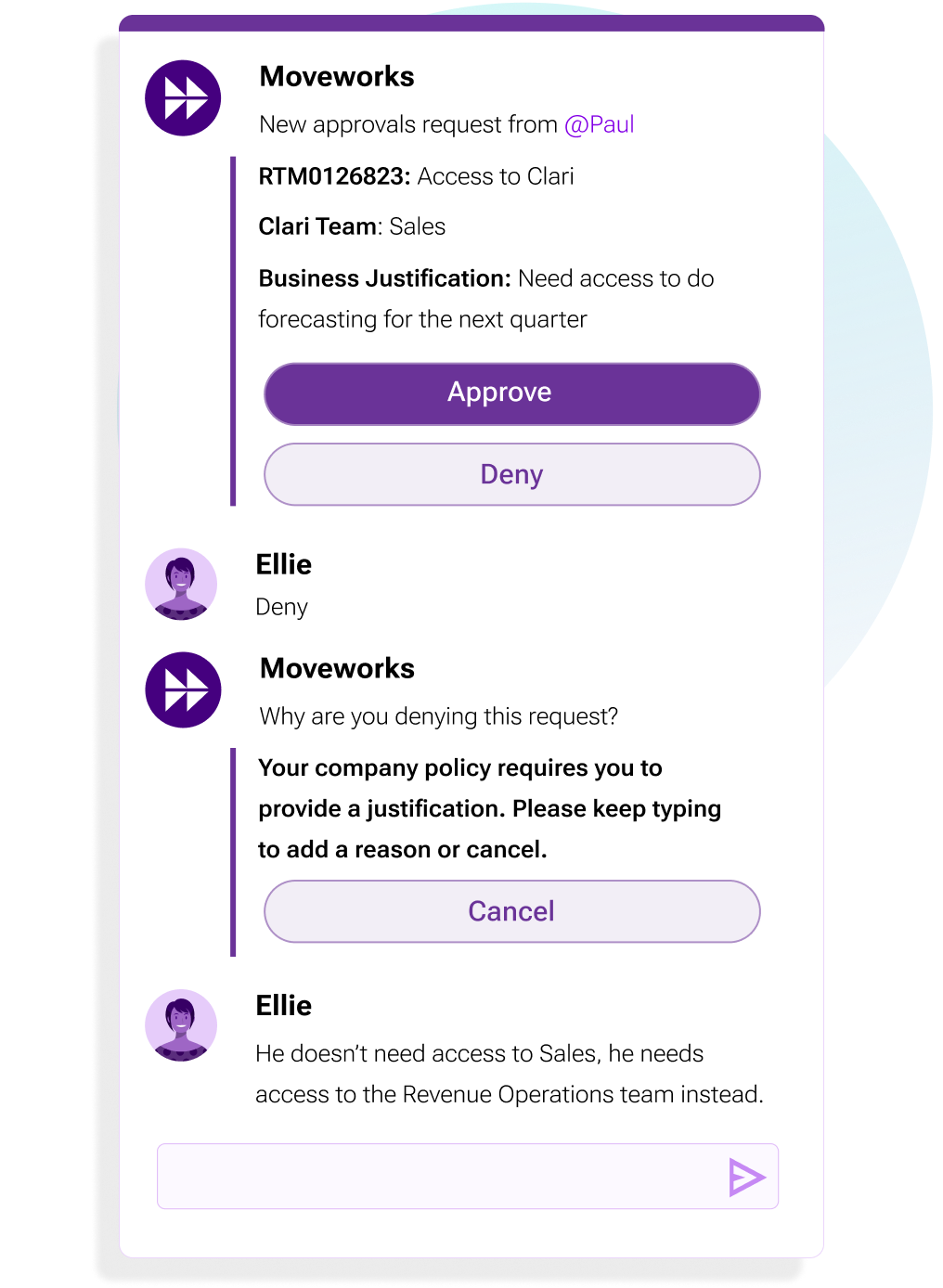
4. Proactive employee communication
AI tools can be proactive in employee communications by sending timely notifications whenever necessary. For example, they could remind new hires to complete benefits enrollment during onboarding.
Agentic AI tools can also recommend learning experiences autonomously based on employees’ roles and previous prompts and take action on your behalf. For example, they could prompt your HR team to review your new policy guide. Then, it could recommend a learning course and help enroll you in it too.
When used for communications, these tools can reduce the risk of missing critical tasks (like filling out employment paperwork) and make employees feel supported.
5. 24/7 multilingual support
Traditional technologies like pre-scripted chatbots have long been the go-to solutions for enterprises because they offer around-the-clock support.
However, they can’t always cut it in the modern workplace. With businesses growing their presence across the globe, dynamic solutions like AI assistants are a better fit for managing specific local and regional needs and different languages.
Some AI tools can understand multiple languages and can tailor responses to employees’ native tongues in real time. When every employee is able to get help whenever they need it in a language that’s easy for them to understand, productivity and satisfaction rises.
6. Workflow automation
Maintaining connected workflows, especially when using different tools, is one of the most significant challenges in IT and HR digital transformation. With some EX technologies, employees may have to constantly switch tools or manually share data across platforms to prevent gaps and siloed processes.
The good news is that AI is able to address this issue. AI-powered tech can connect disparate systems from your ITSM to HRIS, allowing for seamless information sharing and actions across systems.
For example, with AI assistants like Moveworks, employees can request access to enterprise applications on messaging platforms like Slack, file an IT ticket, update their personal information, or request time off without switching back and forth across different systems.
7. Employee experience insights
While periodic employee engagement surveys do provide insights into the employee experience, they may not always reveal the most timely pain points. Plus, issuing and assessing their results can take HR teams’ attention away from other meaningful tasks.
This is one of the reasons why AI tools are such a valuable investment. They can support tickets and offer real-time employee experience insights to help you identify problem IT areas issues before they escalate, promoting timely interventions.
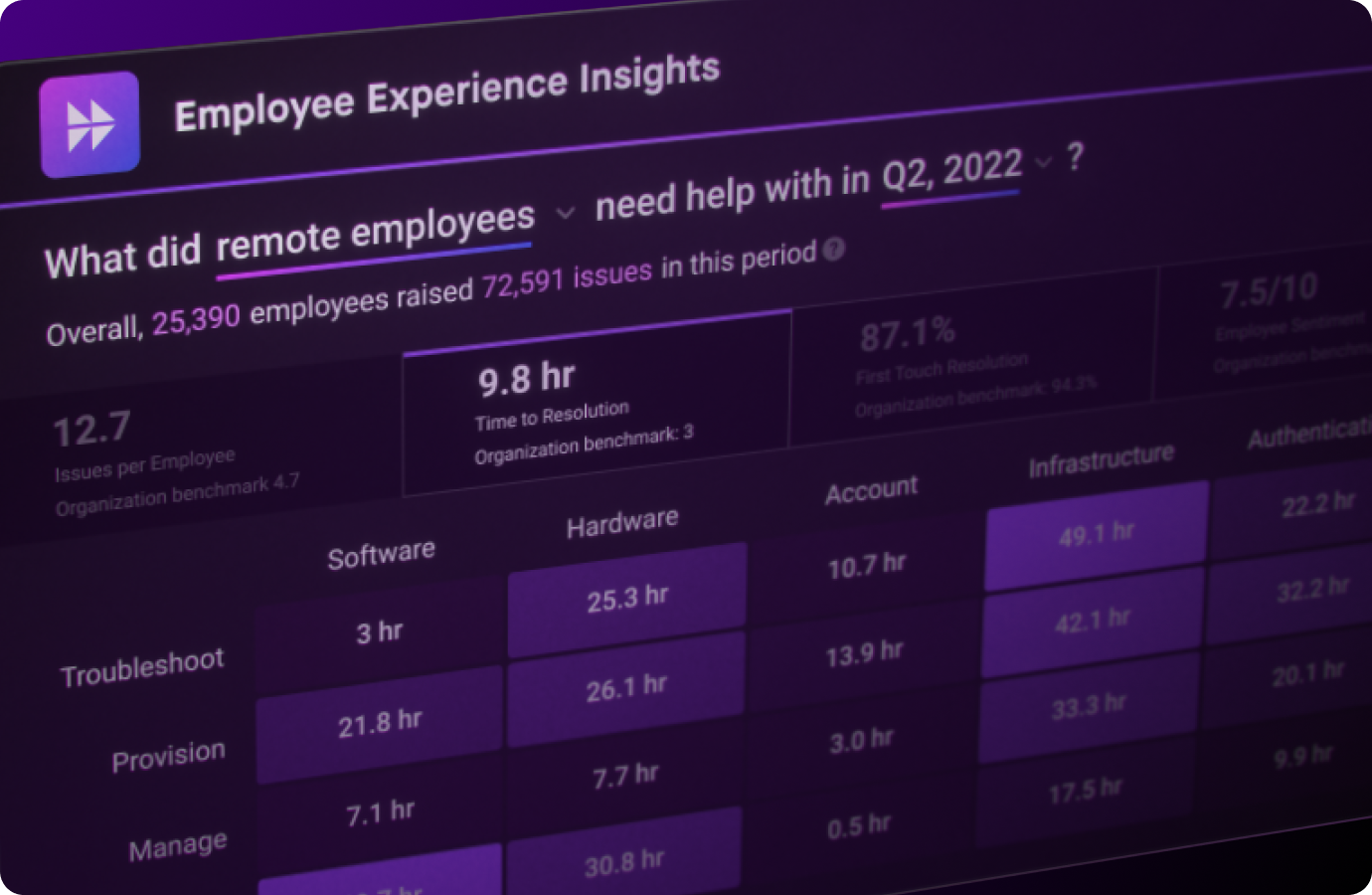
Considerations for choosing an AI-driven EX solution
AI-driven solutions can level up your employee experience — but choose carefully to ensure the solution can deliver impact and is tailored to your needs. Some key features to look for when assessing your options include:
- Advanced NLP and natural language understanding (NLU): Allow your tool to understand the context and intent behind employees’ input, even when their language is ambiguous, allowing for more relevant and helpful responses.
- Integrations with current enterprise applications: Prevent siloed experiences and facilitate seamless workflow automation, which could lead to better employee experiences.
- Multilingual capabilities: Allow you to support a diverse, global workforce.
- Robust security efforts: Includes encryption and multi-factor authentication (MFA), which help to minimize the risk of data falling into unauthorized hands.
- Compliance with relevant privacy regulations: Is able to help to lower your risk of privacy issues.
- Customization capabilities: Allow you to tailor workflows, communication styles, and platform features to align with your company context, culture, and unique enterprise needs.
- Ease of use: Can improve the chances of employees leveraging the tech and shorten the time to value.
- See the tech in action: Consider scheduling a demo with your potential software provider to get a clear picture of your chosen tool’s capabilities.
Empower better employee experiences with Moveworks
As enterprises adopt hybrid and remote work environments and increasingly grow their tech stacks, AI-driven employee experience optimization is more important than ever for HR, IT, and other teams.
The right AI assistant can help automate repetitive tasks, provide quick access to information, and tailor support to employees’ unique needs.
- Moveworks agentic AI Assistant empowers your entire workforce with a secure agentic AI Assistant that accelerates workflows.
- Hundreds of deep integrations and plugins, give your employees one easy-to-use enterprise AI platform to find answers, automate tasks, and boost productivity — wherever they're working.
- Your entire employee experience — now on a single screen. Employee experience insights (EXI) analyzes your support tickets in real time, so you know exactly what to solve next.
- Identify department-level and trending issues in near real time to more effectively shape your service strategy.
Discover how better EX helps your employees to focus on meaningful tasks, increasing productivity, job satisfaction, and employee retention.
Want to learn more about the value of AI in employee experience optimization? Get a personalized demo to see Moveworks in action.
Table of contents
